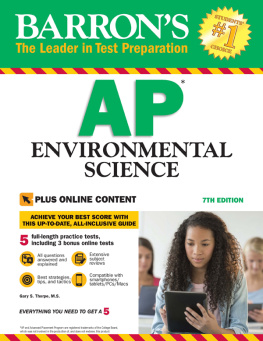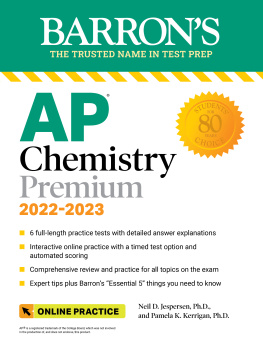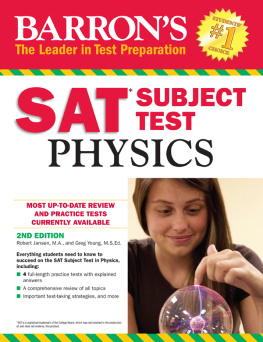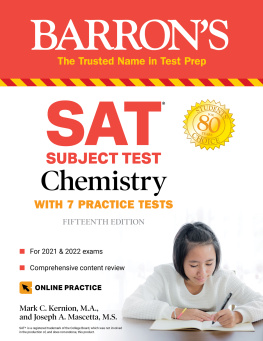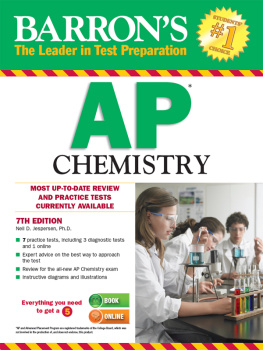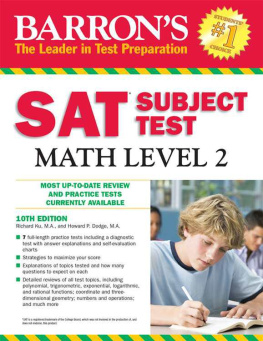
Dedicated
to
my wife, Jean, and daughters, Lisa, Linda, and Lori,and their families,
who supported my efforts throughout the years
About the Author:
Joe Mascetta has taught high school chemistry for twenty years. He was the science department coordinator and principal of Mt. Lebanon High School in Pittsburgh, Pennsylvania. He also served as a science consultant to the area schools and is a past-president of the Western Pennsylvania Association of Supervision and Curriculum Development (ASCD) and the State Advisory Committee of ASCD. He holds degrees from the University of Pittsburgh, the University of Pennsylvania, and Harvard University, and was a participant in Harvard Project Physics, a General Electric Science Fellowship to Union College in Schenectady, New York, the Chemical Bond Approach Curriculum Study at Kenyon College, Ohio, and the Engineering Concepts Curriculum Project and Science Curriculum Supervision at the University of Colorado.
Copyright 2010, 2008, 2006 by Barrons Educational Series, Inc.
Prior editions Copyright 2002, 1998, 1994 by Barrons Educational Series, Inc.,
under the title How to Prepare for the SAT II: Chemistry.
Prior editions Copyright 1990, 1986, 1981, 1969 by Barrons
Educational Series, Inc.,
under the title How to Prepare for College Board Achievement Test in Chemistry.
All rights reserved.
No part of this work may be reproduced or distributed in any form or by any means without the written permission of the copyright owner.
All inquiries should be addressed to:
Barrons Educational Series, Inc.
250 Wireless Boulevard
Hauppauge, New York 11788
www.barronseduc.com
eISBN: 978-1-4380-8374-2
Revised e-Pub publication: August, 2012
Contents


T he SAT Subject Tests are given in specific subject areas to assess your academic abilities for college. They are prepared by the College Board and give evidence about your readiness in specific academic areas. The test can complement and enhance your college admission credentials. The introduction of this book will give you all the basic information you need to know about the subject test in chemistry. To learn additional information about this testing program, go to the website www.collegeboard.org and look under SAT Subject Tests
All of the SAT Subject Tests are contained in the same test booklet. Each takes 1 hour of testing time, and you may choose any one, two, or three tests to take at one sitting.
Many colleges require or recommend one or more Subject Tests for admission or placement. The scores are used in conjunction with your high school record, results on the SAT, teacher recommendations, and other background information to provide a reliable measure of your academic achievements and a good predication of your future performance.
In addition to obtaining a standardized assessment of your achievement from your scores, some colleges use the test results for placement into their particular programs in the freshman year. At others, advisers use the results to guide freshmen in the selection of courses.
Is the SAT Subject Test in Chemistry Required?
The best information on whether SAT Subject Tests are required and, if so, which ones is found in the individual college catalogs or a directory of colleges. Some colleges specify which tests you must take, while others allow you to choose. Obviously, if you have a choice and you have done well in chemistry, you should pick the SAT Subject Test in Chemistry as one of your tests. Even if the test is not required by the colleges to which you are applying, you can add the result to your record to support your achievement level.
When Should You Take the Test?
You will undoubtedly do best if you take the test after completing the high school chemistry course or courses that you plan to take. At this time, the material will be fresh in your mind. Forgetting begins very quickly after you are past a topic or have finished the course. You should plan a review program for at least the last 6 weeks before the test date. (A plan is provided later in this book for such a review.) Careful review definitely helpscramming just will not do if you want to get the best score of which you are capable!
Colleges that use SAT Subject Test results as part of the admissions process usually require that you take the test no later than December or January of your senior year. For early-decision programs, the test time is June of your junior year. Since chemistry is often a junior year course, June of that year is the optimum time to take the test.
When Is the Test Offered?
The chemistry test is available every time the SAT Subject Tests are given, that is, on the first Saturday of October, November, December, May, and June. They are also given on the last Saturday of January. Be sure that the testing site for which you plan to register offers the SAT Subject Tests on each of these six times. Remember that you may choose to take one or two additional tests besides chemistry on any one test day. You do have to specify in advance which tests you plan to take on the test date you select; however, except for the Language Test with Listening, you may change your mind on the day of the test.
How Do You Register?
You may get all of your registration information by going to sat.collegeboard.org/register/how to register. This is the quickest and easiest way to register for the test. This site will give you all the information you need to complete your registration. You can choose your test date and center as well as receive immediate registration confirmation. This website also gives you instructions for how to register by mail.
The deadline for registration is approximately one month before the test date.
How Should You Prepare for the Test?
Barrons SAT Subject Test in Chemistry will be very helpful. The more you know about the test, the more likely you are to get the best score possible for you. This book provides you with a diagnostic test, scoring information, four practice tests and the equivalent of one more test incorporated with the chapter review tests that allow you to become familiar with the question types and the wording of directions, and to gain a feel for the degree of emphasis on particular topics and the ways in which information may be tested. Each of these aspects should be consciously pursued as you use this book.
What Topics Appear on the Test, and to What Extent?
The following charts show the content of the test and the levels of thinking skills tested:



Note: E ach test contains approximately five questions on equation balancing and/or predicting products of chemical reactions. These are distributed among the various content categories.
Next page

